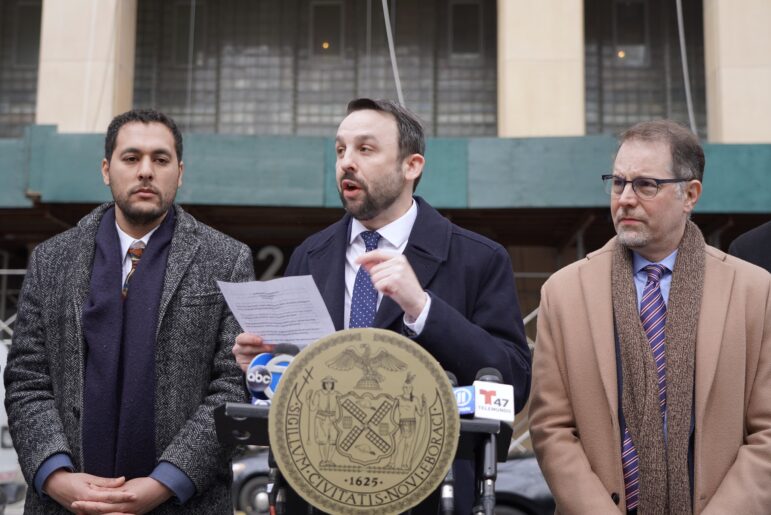Giselle John still remembers the night seven years ago when a city social worker and a police officer knocked on the door of the Brooklyn apartment she shared with some family friends. John, not quite 16 at the time, was an undocumented immigrant from Trinidad. A year earlier, her mother had brought her to the United States to escape years of abuse from the girl’s father. Her mother left John with some friends in New York City and quickly returned to Trinidad.
When the caseworker from the city’s Administration for Children’s Services showed up, John was certain the authorities had discovered her secret–that she was in the country illegally–and had come to ship her back to Trinidad. So she bolted, leapt down three flights of stairs to the street. “I was more afraid of what would happen to me if I went back to Trinidad than if I stayed here and hid from the authorities,” remembers John, now 23 and an advocate for foster children at Voices of Youth, a project of the nonprofit Youth Communications.
They quickly caught up with her, and placed her in a temporary group home, where she kept her immigration status a secret for four months. A caseworker soon discovered she was illegal–she does not know how–and from then on, social workers and lawyers entrusted to keep children safe did more to instill fear in her than to help her ease into life in the United States. An attorney for the Administration for Children’s Services asked a Family Court judge to send her back to Trinidad. The judge refused. A city social worker warned her that if she stayed in foster care she could cause a war between Trinidad and the U.S. “They said, ‘What would happen if Trinidad found out we had one of their people?’” John remembers. “I totally believed them.”
But never during her first few years in foster care did the caseworkers offer to help her become a legal United States resident. Little did they seem to know that under a 1990 federal law, immigrant children in foster care can apply for permanent residency as a “Special Immigrant Juvenile.” Congress wrote the legislation in response to concerns that without the ability to work legally, immigrant young adults would leave foster care unable to support themselves.
Around the country, however, word of the provision, and how to put it to use, has yet to trickle down to most service providers. “You ask clients if they have had sexual abuse, if they’re drinking alcohol, and yet too often you don’t ask them where they were born,” says Max Moran, a social worker with Seamen’s Society for Children and Families, a private agency overseen by ACS. In fact, Ron Cerreta from the Door, one of the few organizations in New York City that provides legal services for foster teens, estimates that in the first five years after Congress enacted the residency provision, less than 100 foster children a year were approved. In New York City, he says, only about 50 immigrant foster kids are made permanent residents annually. While it is not known how many of the 1,000 New York young adults who leave foster care each year are immigrants, the number, child advocates estimate, is much more than 50.
John was one of the lucky few, having read an ad for The Door’s services in a magazine. “I had to take the initiative,” she remembers. It paid off; at age 19, she got her green card.
For every such success story, however, there are many others who leave foster care to live on their own without the right to work legally, receive financial aid for college, access health insurance or public assistance. “They teach me how to cook and clean,” Giselle says of the life skills classes the foster care system provides for teens. “But that’s not on the top of my list when I can’t go to college if I don’t have a green card, and when I can’t get a job.”
That could soon change, however. After conducting a year-long study of immigrants in the city’s foster care system, the Immigration and Child Welfare Project, a coalition of child welfare advocates, convinced the Administration for Children’s Services to try to make immigration a regular part of foster care workers’ vocabularies. In January, ACS hired the project to train the city’s child welfare workers on the ins and outs of the nation’s immigration system. Under the $40,000 contract, child welfare workers with expertise in these issues will spend a year teaching about 720 caseworkers everything from how to decipher immigration papers and determine a client’s immigrant status, to where to refer foreign-born kids for help when they aren’t eligible for government support to how to apply for a green card.
This training will mark the first time the city has given its foster care workers an extensive how-to on dealing with immigrant children and families.
Without this training, the results have at times been disastrous for kids, says Ilze Earner, founder and director of the Immigration and Child Welfare Project. Nationwide studies show that many former foster kids end up homeless and on welfare. One such study, by Mark E. Courtney at the University of Wisconsin, found that 32 percent of young adults who’d been out of care for 12 to 18 months were receiving public assistance, and only two-fifths of them were employed. For kids who are not legal residents, collecting welfare and working, at least legally, are not options. Instead, they must rely on friends, or on the families from whom they were taken away, sometimes returning to the dangerous situations that put them in foster care in the first place. John knows of one young man who left foster care without working papers, got in trouble with the law, and was deported to his home country.
Getting legal residency is not the only thing Earner plans to focus on in the trainings. During her 20 years in social work, she has seen cultural misunderstandings lead caseworkers to remove a child from a home because it was allegedly overcrowded. In other cases, illegal immigrant families who’ve had trouble putting food on the table or required medical attention have lost a child to foster care because they couldn’t apply for public assistance to keep the family together.
The immigration project expects the training, slated to start this summer, to put an end to some of these complications. When caseworkers do help foster kids become legal residents, Earner says they sometimes lose documents, like birth certificates and Social Security cards, that are critical to the green card application process. Or they wait until just months before a foster child is scheduled to leave the system to start the residency application process, which usually takes two to three years. Once a child leaves foster care, by age 21 in New York, he is no longer eligible.
In those cases, “Immigration has no obligation to give them an appointment just because they’re about to age out,” says Ron Cerreta of The Door. “Their reason is, ‘You should have gotten it to us sooner.’ And that’s right. But who was responsible for getting it to their attention in the first place? Foster care.”
Kendra Hurley is editor of Foster Care Youth United, a magazine written by and for teenagers in foster care and published by Youth Communications.








